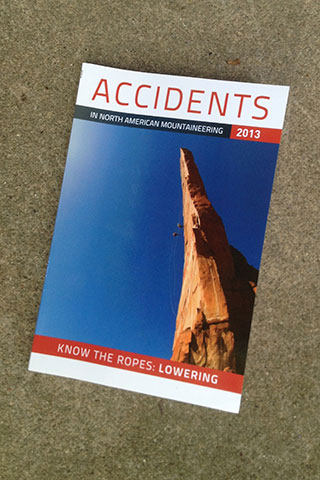| 855 | Accidents in North American Mountaineering, 2013 |
2013-09-11 |

In the late summer of each year, the American Alpine Club publishes Accidents in North American Mountaineering.
Starting last year, 2012, an educational topic was included in the new Knowing the Ropes section of the book. While reading the pages of reported accidents, it is obvious that many of the incidents could be prevented if climbers practiced safer techniques. Knowing the Ropes is meant to increase climbers' awareness and skill levels and hopefully reduce the number of accidents. The Knowing the Ropes topic for 2012 was Rappelling and for 2013, the topic is Lowering.
In the chapter - Accidents and Analyses - Learn from Other's Mistakes, the editors describe some of the accidents that occurred in the preceding year (the 2013 book covers the accidents from 2012) and gives analysis or insights to the causes of the incidents. Some of the accidents were self reported and others were documented by the land managers. By far, most of the reports came from the National Park sources.
We all make mistakes in our outdoor travels. Most mistakes occur, without serious consequences; but other times the participants are not as lucky. These are some of the accidents that are reported. Read, learn, practice, and be careful.
A few stats ...
In America and Canada there were 18 rappelling accidents.
There were 9 belaying problems. Two of these accidents were where the rope slid through the belay device.
13 accidents occurred while climbing unroped and/or scrambling.
A few of the accidents ...
Meet Up groups help hikers, climbers, adventurers, etc find partners. Many folks who might not ever hike a trail or canoe a river alone, would however participate as a part of a group. It is social adventure! One of the difficulties for a Meet Up is leadership. Not only are there difficulties in finding leaders, but there may be issues in the group working as a unit. In this report, one member of a group climbing Mount Shasta decided to take a nap and separated from the others. He was inexperienced. He continued to the summit and descended the wrong route. Luckily he met a guided group. There was no accident, just an almost lost incident. (Accidents in North American Mountaineering - 2013, p 32)
Also on Mount Shasta, a guided group while on a climb sent a per-determined SPOT (a satellite communication device) message. The message was for help, but did not require immediate attention. Well, the sender thought he had changed the message to say, he was running a little late, not calling for help. (p 33)
In Yosemite, a 50 year old, experienced climber, left his warm clothes at the base of the cliff following a warm forecast. He and his partner were caught in a cold, rainstorm that slowed their progress and increased the time they had to spend under-clothed and exposed to the elements. There was no real accident, the report was made because the climber reported that he had to leave his pack at the base and didn't want anyone to go out looking for him. (p 35)
In Boulder, CO, a climber on an easy route ran the rope out to the end. He was not at a belay stance, so he decided to untie and continue climbing. His belayer then started climbing, thinking he was on belay. The second (the original belayer) slipped and fell forty feet to the ground. (p 46)
On Mount Hood in Oregon, a mid-westerner decided to attempt a climb without an ice axe or crampons. Instead, he was climbing the mountain with only his trusty walking stick. (p 79)
In the Tetons, a climber was intending to climb the South-West Couloir (a moderate scramble). He attempted instead the South-East Ridge (a relatively difficult mountain route requiring rope, gear, and experience). Somehow the climber mistook the one route for the other (the two routes are not even close and the start of the South-West Couloir is very obvious). (p 98)
A tragic incident occurred on Mount Rainier. While working a rescue high on the mountain, a ranger slipped on a glacier and fell to his death. Rangers and rescue personnel risk their lives to save others. (p 89)
Be safe. Climb safely.
Happy Safe Climbing trails
